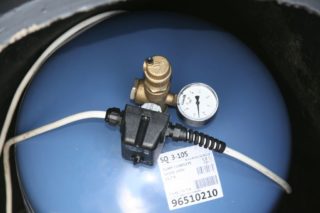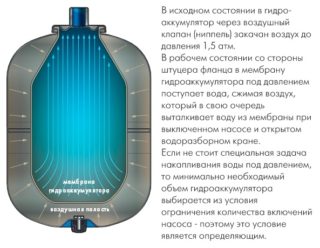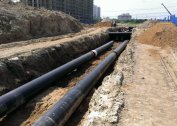The expansion tank is almost indispensable in the water supply of a country house. It allows you to stock up on an additional volume of water in case of shutdown, or to avoid the loss of this fluid when it is heated by the boiler system.
Functions of expansion tanks for water supply systems
The expansion tank with internal pressure is universal, therefore it can be used for several purposes. The first method of application is in the water heating system with boilers as an additional capacity for removal during thermal expansion. Another application is a hydraulic accumulator.
Despite the different functions performed, the tank in both cases has an identical design. It consists of a closed-type steel casing with an internal space that is divided in half by an elastic membrane. The upper compartment contains compressed air (sometimes nitrogen is used), and liquid is pumped into the lower compartment.
Expansion tank as a battery
The tank is connected to the system in order to accumulate additional water in case the water supply stops. The principle of operation is this: the tank is connected by a pipe to the water pipes at any point, and when the tap is opened, water begins to fill the tank. A non-return valve is installed on the connection, preventing water from pouring back.
As soon as the liquid enters, the membrane begins to move up until the pressure of the compressed air above it is equal to the pressure of the water in the system. It is worth considering that the useful volume of the tank is approximately half of the total. In times of shutdown of the water supply, the fluid can be pumped out of the tank through another valve.
Expansion tank for boiler
Water tends to expand when heated. When its temperature rises, the volume begins to increase. Since the capacity of the heating system is initially completely filled, excess liquid flows out.
To avoid water losses, an expansion tank is additionally used, which is installed above the boiler. He takes in the surplus. Useful space inside the tank should be approximately 10% of the boiler volume.
Normal pressure
The unit manual says what pressure should be in the expansion tank of the water supply system by default in this configuration. It usually ranges from 1 to 3 bar.
The required indicator also depends on where the tank is located relative to the water supply system to which it is connected. According to standard rules, there should be 0.2 atmospheres more in the tank. If they are located on the same level, this difference will suffice.
If the height between the expansion tank and the heating system is 12 m, an additional 1 atm must be added for every 10 meters. It turns out that for the given conditions, the pressure inside the tank will be normal, which is 0.2 + 1.2 = 1.4 atmospheres above the water supply.
How to measure the pressure in the expansion tank
 There are two ways to find out under what pressure the gas is inside. If a pressure gauge is attached to the expansion tank from the outside, its scale will show these indicators. It is advisable to make sure that the device is working correctly. Pre-shut valves to separate the tank from the water system. After 10 minutes, you must first pump up, and then again bleed the air in the tank, while observing the behavior of the arrow. If she moves, and her movements are smooth, then everything is in order.
There are two ways to find out under what pressure the gas is inside. If a pressure gauge is attached to the expansion tank from the outside, its scale will show these indicators. It is advisable to make sure that the device is working correctly. Pre-shut valves to separate the tank from the water system. After 10 minutes, you must first pump up, and then again bleed the air in the tank, while observing the behavior of the arrow. If she moves, and her movements are smooth, then everything is in order.
If the tank does not have a built-in pressure gauge, you must use a portable analogue. The removable device for measuring pressure has the same connector as on the exhaust valve of the expansion tank in the upper part. It must be put on and tightened. Then open the valve so that the pressure gauge with the tank becomes one system. The device arrows will show the current internal pressure.
Performance Adjustment
At times, the pressure in the expansion tank drops, so it must be periodically pumped up so that the efficiency of the device remains at the same level. Each membrane tank has a spool. You can connect a bicycle or car pump to it, or a cylinder with compressed gas.
The membrane water tank can be inflated manually or using an automatic pump. If you are using a can of compressed air, additional effort is not required. It is necessary to connect it to the container with a special hose. Then open the gas release valve on the cylinder, which under pressure itself will fill the closed expansion tank.
It is necessary to carefully monitor the pressure gauge to tighten the valve in time, as soon as the correct pressure is established inside.




